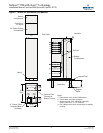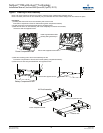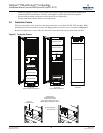
NetSure™ ITM with eSure™ Technology
Installation Manual, Section 6040 (Issue AB, April 8, 2013)
Spec. No: 582145500
13
Section 6040
Model: NetSure™ ITM Issue AB, April 8, 2013
3.0 P
OSITIONING
THE
DC UPS S
YSTEM
This section describes the environmental and mechanical considerations that must be taken into
account when planning the positioning and cabling of the DC UPS system. This section also provides
procedures for physical installation of the DC UPS cabinet.
Because every site is unique, some subsections present a guide to general procedures and practices
that should be observed by the installing engineer, rather than step-by-step installation instructions.
3.1 General Requirements
• The installer should be familiar with the installation requirements and techniques to be used in
securing the DC UPS module (cabinet) to the floor. It is up to the customer to determine the
requirements for anchoring the cabinet to the specific type of floor at the site, select proper
anchors, and to investigate the proper use of the anchor.
• This product is intended only for installation in a Restricted Access Location on or above a non-
combustible surface.
• Front and rear access is required for installation and operation (see Clearances in this section).
3.2 General Guidelines for Positioning the DC UPS Modules
Choose a location for the DC UPS system that offers:
• Easy connection to inputs, outputs, and alarms.
• Air circulation sufficient to expel heat produced by the DC UPS system.
• Protection against moisture and excessive humidity.
• Protection against dust and other particulate matter.
• Enough space to service the DC UPS system (see Clearances in this section).
• Compliance with fire prevention regulations and practices.
3.2.1 Cable Entry
DC distribution and alarm cables enter the DC UPS module from the top or bottom, depending on
module configuration (top distribution feed or bottom distribution feed).
AC input cables can enter either at the top or bottom. Conduit openings are provided in both
locations.
3.2.2 Environmental Considerations
Before installing the DC UPS system, verify that the room satisfies the environmental conditions
stipulated in 7.2 - Environmental, paying particular attention to the ambient temperature and air
exchange system. Also refer to 7.2 - Environmental for details on heat dissipation.
The DC UPS system should be installed in a cool, dry, clean-air environment with adequate
ventilation to keep the ambient temperature within the specified operating range +23°F to +95°F
(-5°C to +35°C).
• Batteries are installed in the DC UPS module’s battery compartment. Temperature is a major
factor in determining battery life and capacity. Battery manufacturers recommend an operating
temperature of 77°F (25°C). Ambient temperatures higher than this reduce battery life;
temperatures lower than this reduce battery capacity. For optimal battery performance and
service life, inlet air temperature to the battery compartment (from the front of the system)
should be maintained between +68°F to +77°F (+20°C to +25°C).
The DC UPS module is cooled by internal fans. Cooling air enters the system through the front of the
unit and is exhausted out the top. To permit proper air flow and prevent overheating, do NOT block or
cover the ventilation openings or blow air down onto the unit. Ventilation clearance above the unit
must be a minimum of 8 in. (203mm).


















